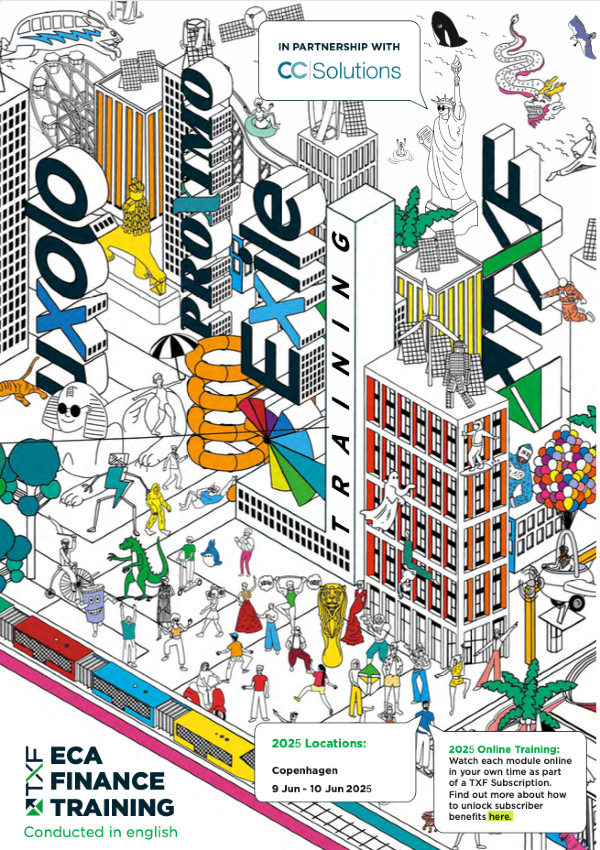A new trade takes shape
Ahead of Sibos 2019 in London this September, CGI’s Rory Kaplan, Senior Offering Manager for Trade and Supply Chain Solutions, and Patrick DeVilbiss, Product Manager for Trade and Supply Chain Solutions, explain how a focus on user experience and short-term practical developmental projects are paving the way for the future of trade.

 The
The re are now much higher expectations of how an online or mobile product or portal should look and behave, and these are increasingly dictated by experiences in the consumer digital world. These higher expectations have begun to permeate the development of digital trade finance solutions.
re are now much higher expectations of how an online or mobile product or portal should look and behave, and these are increasingly dictated by experiences in the consumer digital world. These higher expectations have begun to permeate the development of digital trade finance solutions.
Rory Kaplan (right), senior offering manager for trade and supply chain solutions at CGI, explains: “This is something that we really started to see last year, and it has coalesced into a real trend. Personal experiences in social media and consumer banking in particular, have greatly influenced what trade finance customers want to see in their business environments, and these new expectations are pushing trade forward.
“The way this is manifesting itself is trade finance customers now demand a better customer experience with speed, efficiency, and a more streamlined and efficient process. In turn, this is really forcing banks to set development priorities, with user experience at the top of the list.”
There is more than anecdotal evidence to support this, with notable improvements in some bank portals and a push towards an omni channel approach to access bank products and services. With the help of Fintechs, banks have been able to roll out much slicker offerings.
Patrick DeVilbiss (left), product manager for trade and supply chain solutions at CGI, notes: “There’s definitely much more of a focus on human-centered design to make sure that applications, be they mobile, desktop or otherwise, really resonate with the user and allow them to access services in as user friendly way as possible.”
He continues: “What has changed is that rather than simply moving a paper process online, the industry is paying attention to what steps users have to go through to input data or fill in a form. How can these processes be made better? What our bank clients are seeing is better design and a better experience can lead to an uptick in usage of their portal, and ultimately a focus on the end-user is leading to improved efficiency and revenue generation.”
A change in attitudes has also pushed many institutions to focus on deliverables that are more realistic. There has been real progress in the fields of intelligent process automation, data capture and artificial intelligence.
Blockchain is still in early stages as some trade and supply chain finance applications have launched. Banks continue to show interest; however, many have moved this down their priority lists awaiting broader based use and adoption.
Says Kaplan: “The focus of digital development in trade at the moment revolves around the use of APIs and around the themes of efficiency, interoperability and interconnectivity.”
Adds DeVilbiss: “Efficiency really comes down to being able to do more with less, and we are now starting to see some really interesting initiatives on the analytics side with intelligent process automation, where you combine robotic cross examination and machine learning.”
All of the consortia and networks emerging with new initiatives rely on the concept of interoperability. What this means in practical terms for the banks is that they have to make it a priority to look at their underlying architecture and ask whether they are structured in a way that allows them to quickly connect to one of these new external networks. Ease of communication is key, and it is encouraging to see the industry begin to coalesce around new standards.
Getting mobile and capturing data
What is working, and what is not, at this stage of trade’s evolution? One area in which digital trade has really moved forward is the deployment of mobile portals – a standard in our daily lives for some time in so many other sectors. Says Kaplan: “Having features of the CGI Trade360 portal for mobile devices has been a good first step, however to create the user experience desired by customers, banks will need to explore and add new and creative uses of mobile for trade going forward. This will lead to us seeing its capabilities expand to appeal to a broader audience in the near future. We have seen this happen tremendously quickly in other industries.”
Kaplan continues: “The challenge is recreating aspects of the functionality and user experience of our portal for mobile technology, and that is where the use of APIs has grown. Now we are moving beyond what we already offer. We have seen cloud-based ERP systems using APIs, and we will use them for the uploading of invoices and purchase orders for supply chain finance or other services.”
“Banks may not want to build certain functions in-house, such as electronic documentation or an electronic bill of lading, however, the use of APIs and interoperability would allow them to expand service offerings such as essDOCS, for example.”
A further area of development in which there has been more cautious progress is intelligent data capture. Says Kaplan: “With companies offering accuracy rates of approximately 90%, when it comes to the POC stage it becomes apparent that while the technology is new and cutting edge, it takes an intense education process to learn the new technology and teach it what you would like it to do in terms of document classification and what to do with data points and other parameters – only then will machine learning really work. There has been some recent success from a few banks, but that has taken upwards of 18 months to achieve a level that can lead to commercialization. While some applications are now in the adoption stage, others have a way to go.”
An ideal of where the industry should be heading does exist, and there are groups in the market that want to be a ‘Facebook of trade’. Says DeVilbiss: “The goal is to have a network where all participants are exchanging documents in a single ecosystem, in a seamless manner through a fully-digitized, end-to-end process. At the moment, there are so many disparate parties and they all have completely different incentives and value-adds in mind to any underlying transaction. The struggle is getting each of those participants on a single network or getting to a point where multiple networks can communicate with each other. We all want to get to the same place but getting there is a challenge we still have to overcome.”
A more collaborative space
On a positive note, what is working in trade is a very real sense of collaboration. Going back five or six years, it seemed that all the talk in trade was about regulation and compliance. “It was a depressing time for trade,” recalls DeVilbiss. “But if you flash forward to today, all the banks have come to the realization that if they don’t come together and figure out a better way of doing trade in the digital age, someone else is going to and they are going to be left out of the party – something that they certainly do not want to see.”
Indeed, with the plethora of networks and companies offering digital trade solutions, perhaps the biggest challenge for the banks is in the initial evaluation of who fits their needs best and how they should work with them. These are not easy decisions for banks. It is crucial to start with a coherent strategy, as well as deciding on your areas of focus.
Kaplan explains: “We personally feel that intelligent process automation and the related analytics are the best places to start. It’s a big step towards paperless trade, which has been a goal for the industry for many years.”
He adds: “Many banks have set up innovation labs to help make these decisions easier through focused investigation and experimentation, and it’s interesting to see how they have been able to direct developmental focus. For example, the initial excitement around block chain has toned down in favor of achievable, pragmatic goals. We have 20 banks on our platform and the attitude towards blockchain as a priority has shifted and been replaced by user experience for corporates. That has certainly informed decision-making.”
CGI’s role in this ecosystem is as a hub for trade banks. CGI will continue to build functionality and is ready and willing to interoperate through APIs to the CGI Trade360 platform. With an architecture that is particularly conducive to interoperability, CGI is keen to work with other Fintechs and partners across the whole trade space and meet the needs of banks’ corporate trade clients.
“Many banks servicing a large corporate rely on the corporate to drive what solutions to build that will meet their requirements. The corporate will tell the bank what they want, and we will build a solution integrated with CGI Trade360. It’s not ‘Build it and they will come’ – it is much more reactive than that, and banks have become much more agile than in the past,” explains Kaplan.
DeVilbiss concurs: “From the bank perspective, you also have to remember they are servicing a complex array of corporate clients from two-person suppliers all the way up to companies the size of Walmart. It is challenging to make sure that you have solutions for the entire client base. Ultimately, they will all want something faster, easier and cheaper to use, but the scale can be very different.”
Work smarter, do more
One of the greatest concerns for the banks is being able to pitch for investment internally. There have been several false dawns over the years when it comes to trade finance technology solutions, and with so much emphasis on compliance in recent years, obtaining dollar spend on development has been a challenge.
Encouragingly, banks are increasingly embracing the concept of the smart worker, and compliance in relation to trade finance has been singled out as a prime area for intelligent data capture, machine learning and automation. Technology investment can allow for the redeployment of human capital away from more monotonous tasks and, in compliance, into areas that require more in-depth investigation.
Indeed, it is in this internal use of technology that we are seeing the start of the biggest shift in the recreation of trade for the digital age. Says Kaplan: “Some of the larger banks have a real vision for what the industry will look like in the future and that is really helping drive things forward. In four or five years we’re going to see significant differences to how trade works – and that is why now is the time to act.”
DeVilbiss concludes: “It is critical to have a really sharp, short-term focus on what delivers tangible value now. Things that can simplify and speed up processes, and generally increase efficiency. These are the basis of the long-term vision of what trade will be in the future. This is the hard work phase of building the new trade finance, and those that are willing to put in the work are the ones who are going to succeed.”
This sponsored article appears in TXF’s London Calling! Supplement to Sibos





